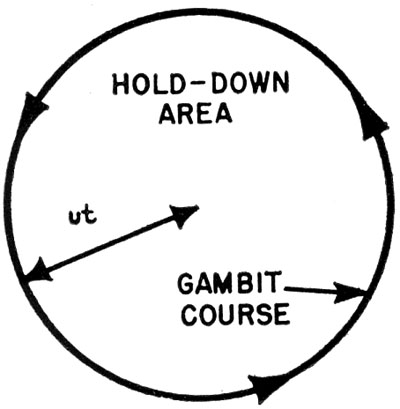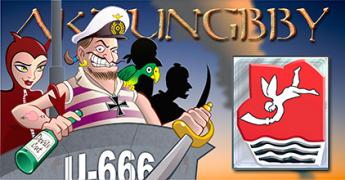 09-16-15, 12:38 AM
09-16-15, 12:38 AM
|
#356
|
|
Gefallen Engel U-666
Join Date: Jul 2013
Location: On a tilted, overheated, overpopulated spinning mudball on Collision course with Andromeda Galaxy
Posts: 27,871
Downloads: 22
Uploads: 0
|
 Chance of depth charge success: 6%
Chance of depth charge success: 6%
Quote:
|
Originally Posted by Barkerov
To get to 40ft with a 0.1 second fuse it is easy to see that it has to travel downward at 400ft per second, a value which I find very hard to believe. A half second fuse which you suggested would detonate at 225-375 feet deep would require downward motion equal to the impact velocity. This would defy the laws of physics.
|
 The teardrop-shaped United States Mark 9 depth charge entered service in the spring of 1943. The charge was 200 lb (91 kg) of Torpex with a sinking speed of 14.4 ft/s (4.4 m/s) and depth settings of up to 600 ft (180 m). Later versions increased depth to 1,000 ft (300 m) and sinking speed to 22.7 ft/s (6.9 m/s) with increased weight and improved streamlining. Roughly 5 seconds per 100 feet. Note the sink times: http://www.ussslater.org/tour/weapons/dpthchrg/dpthchrg.html The teardrop-shaped United States Mark 9 depth charge entered service in the spring of 1943. The charge was 200 lb (91 kg) of Torpex with a sinking speed of 14.4 ft/s (4.4 m/s) and depth settings of up to 600 ft (180 m). Later versions increased depth to 1,000 ft (300 m) and sinking speed to 22.7 ft/s (6.9 m/s) with increased weight and improved streamlining. Roughly 5 seconds per 100 feet. Note the sink times: http://www.ussslater.org/tour/weapons/dpthchrg/dpthchrg.html  And then watch out for serious hunting from the air in 'follow-on' attacks And then watch out for serious hunting from the air in 'follow-on' attacks http://www.ibiblio.org/hyperwar/USN/rep/ASW-51/ASW-13.html http://www.ibiblio.org/hyperwar/USN/rep/ASW-51/ASW-13.html
Quote:
|
Originally Posted by Barkerov
I have probably taken this quote too far out of context but there must be a reason why planes carried depth charges instead of bombs.
|
Footnote to history!: The first to deploy depth charges from airplanes in actual combat were the Finns. Experiencing the same problems as the RAF with insufficient charges on anti-submarine bombs, Captain Birger Ek of Finnish Air Force squadron LeLv 6 contacted one of his navy friends and suggested testing the aerial use of standard Finnish Navy depth charges. The tests proved successful, and the Tupolev SB bombers of LeLv 6 were modified in early 1942 to carry depth charges. The success of the anti-submarine missions reached RAF Coastal Command, which promptly began modifying depth charges for aerial use. [wiki] Thank heavens there were so few Squids: note the sink rate: Squid consisted of a pair of three-barrel mortars whose pattern of six depth charges was normally fired dead ahead, but could be trained 30 degrees to the sides if warranted. Each charge weighed 390 lbs (177 kg) of which 207 lbs (94 kg) was minol. These had a sinking rate of 43.5 feet per second (13.3 m/s) and the fuses operated by clockwork. The pattern was overlapping triangles 40 yards (37m) on a side with the depth of the triangles set 60' (18m) apart. Squid was equipped with a fire control system that was tied directly into Type 147 sonar (no 'blind spot') and automatically set the detonation depth and fired the charges from the mortars at the right moment. It was estimated that Squid was nine times as effective as a conventional depth charge attack, or over twice as effective as Hedgehog, with about a 40.3% probability. The first to deploy depth charges from airplanes in actual combat were the Finns. Experiencing the same problems as the RAF with insufficient charges on anti-submarine bombs, Captain Birger Ek of Finnish Air Force squadron LeLv 6 contacted one of his navy friends and suggested testing the aerial use of standard Finnish Navy depth charges. The tests proved successful, and the Tupolev SB bombers of LeLv 6 were modified in early 1942 to carry depth charges. The success of the anti-submarine missions reached RAF Coastal Command, which promptly began modifying depth charges for aerial use. [wiki] Thank heavens there were so few Squids: note the sink rate: Squid consisted of a pair of three-barrel mortars whose pattern of six depth charges was normally fired dead ahead, but could be trained 30 degrees to the sides if warranted. Each charge weighed 390 lbs (177 kg) of which 207 lbs (94 kg) was minol. These had a sinking rate of 43.5 feet per second (13.3 m/s) and the fuses operated by clockwork. The pattern was overlapping triangles 40 yards (37m) on a side with the depth of the triangles set 60' (18m) apart. Squid was equipped with a fire control system that was tied directly into Type 147 sonar (no 'blind spot') and automatically set the detonation depth and fired the charges from the mortars at the right moment. It was estimated that Squid was nine times as effective as a conventional depth charge attack, or over twice as effective as Hedgehog, with about a 40.3% probability.
__________________

"Only two things are infinite; The Universe and human squirrelyness; and I'm not too sure about the Universe"
Last edited by Aktungbby; 09-16-15 at 12:50 AM.
|

|

|